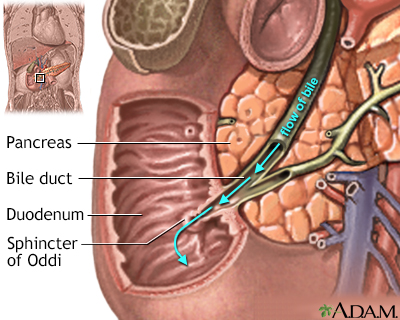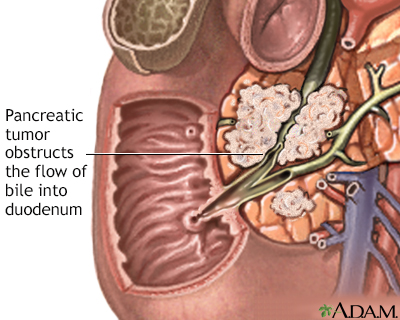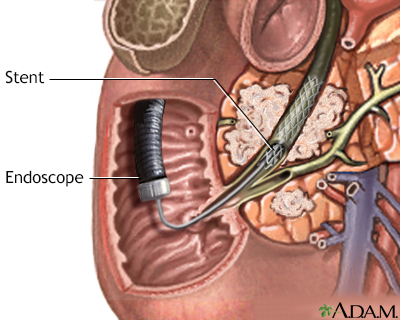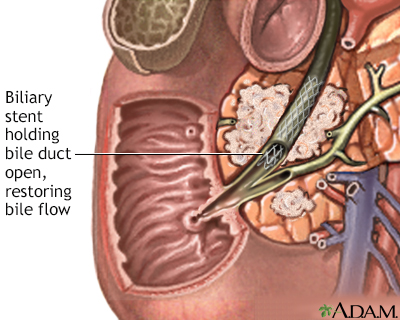Biliary obstruction
Normal anatomy
|
|
Bile is a digestive fluid secreted by the liver and stored in the gallbladder which normally is released into the duodenum portion of the small intestine through the sphincter of Oddi. Bile, released after a meal containing fats, aids in absorption and digestion of the fat.
|
Indication
|
|
Biliary obstruction occurs when the duct which transports bile from the liver to the small intestine (duodenum) is blocked by a stone, a tumor, an injury or inflammation of any of the ducts. A tumor in the pancreas may press in on the ducts, causing a backup of bile in the gallbladder. Blood tests may indicate a high level of bilirubin, a waste product of the liver, or diagnosis may come from an endoscopic examination. Untreated biliary obstruction may cause life-threatening infection or chronic liver disease.
|
Procedure
|
|
One method of relieving a blockage of the bile duct due to pancreatic tumors is the placement of a stent, a device designed to hold tube-shaped structures open. An endoscope (an instrument placed down the throat into the esophagus, through the stomach to the duodenum of the small intestine) helps the surgeon to see the blockage and to place the stent in the correct position. Dye may be injected and X-ray images taken to insure the stent is correctly placed and the flow of bile is restored.
|
Aftercare
|
|
Once the flow of bile is restored, the threat of infection and inflammation is decreased. However, the prognosis may not be significantly altered if the pancreatic carcinoma is otherwise untreatable. Reoccurrence of the blockage (restenosis) may also occur, requiring further surgery or replacement of the stent.
|

Review Date:8/28/2023
Reviewed By:Todd Gersten, MD, Hematology/Oncology, Florida Cancer Specialists & Research Institute, Wellington, FL. Review provided by VeriMed Healthcare Network. Also reviewed by David C. Dugdale, MD, Medical Director, Brenda Conaway, Editorial Director, and the A.D.A.M. Editorial team.
The information provided herein should not be used during any medical emergency
or for the diagnosis or treatment of any medical condition. A licensed medical professional
should be consulted for diagnosis and treatment of any and all medical conditions. Call 911
for all medical emergencies. Links to other sites are provided for information only -- they
do not constitute endorsements of those other sites. © 1997-A.D.A.M., Inc. Any duplication or distribution of the information contained herein is strictly prohibited.
The Agency for Health Care Administration (Agency) and this website do not claim the information on, or referred to by, this site is error free. This site may include links to websites of other government agencies or private groups. Our Agency and this website do not control such sites and are not responsible for their content. Reference to or links to any other group, product, service, or information does not mean our Agency or this website approves of that group, product, service, or information.
Additionally, while health information provided through this website may be a valuable resource for the public, it is not designed to offer medical advice. Talk with your doctor about medical care questions you may have.




